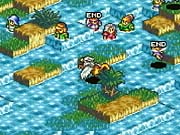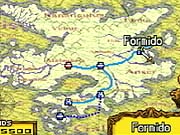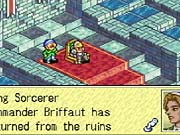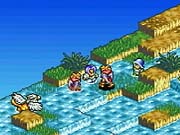Tactics Ogre: The Knight of Lodis Preview
We spend some time with a fully-playable version of this upcoming strategy-RPG.

Though its popularity has never reached that of Final Fantasy Tactics, Tactics Ogre is still one of the most highly regarded strategy console series. The most recent game in the series, The Knight of Lodis, continues in the footsteps left by its predecessors--it has an in-depth and involving storyline, shares the series' distinct visual style and map structure, contains a wealth of options, and features gameplay that's both simple and incredibly dynamic. In fact, it seems that Quest has managed to strike a successful balance between the strategy elements and the role-playing elements so that fans of either will have some motivation for playing The Knight of Lodis on the Game Boy Advance.
If you've played previous Tactics Ogre games or Final Fantasy Tactics, then The Knight of Lodis should feel familiar, but if you haven't had the pleasure of playing either, the game can seem a little overwhelming at first. The Knight of Lodis is essentially a turn-based strategy game in which the main character, along with a series of other characters, fight on an isometric map that has varying types and levels of terrain. Like a field general, you must maneuver your characters and place them on the map into positions that would enable them to attack a member of the opposing party or, at least, get out of harm's way. Sounds simple enough, and for the most part, it is--your main objective is almost always to take out the enemy, but you'll quickly find that running into a battle headfirst by moving your troops haphazardly isn't a useful strategy.

The positioning of your characters on the battlefield is as important as any other aspect of the game. At the start of each battle, you'll be able to select characters from your current group, which is made up of one or two special characters who are directly involved in the story, as well as four or five generic characters who assume the role of melee soldiers, magic users, and archers. Up to eight of these characters can be placed on one side of the battlefield--opposite of the enemy force--before the actual battle starts. In the initial parts of the game, this particular feature isn't quite as important as it is later because the enemy has low numbers and is usually weak, containing only similarly generic characters. But as you progress through the game, the prebattle character-selection feature becomes increasingly important because it will let you assess the battle and select characters who are the most adequately prepared to handle the task at hand.
When the battle begins, you can start moving your characters around on the map. When you select a character with the icon, a grid of blue squares appears on the map, indicating where that particular character can move. The number of squares that are highlighted in blue is often determined by the type of terrain. For example, if you're fighting on a map with sharp cliffs or just generally uneven terrain, then your characters can't move as well. Even if the map is perfectly flat, characters are somewhat restricted in their movements, depending on their class.

Like many current PC RPGs, Tactics Ogre: The Knight of Lodis lets you change the class of characters that fight alongside you. As previously mentioned, most of these characters start out in a generic base class of the three major areas of combat--melee fighting, magic using, and long-range attacks--which enables you to determine how they grow over the course of the game. But before you can actually change the class of your characters, they have to gain some experience on the battlefield and raise their levels. When a few battles have been completed and you feel like it's time for your characters to start specializing in certain areas, then you can enter the character-management screen, which is accessible via the overhead map area. To change a character's class, you simply select the class option, choose the classes from the menu (there are only four or five classes initially available), and then pick the character you want to change.
Assuming that this character meets all the requirements, you'll then be asked to select from one of four elementals for the character. These elementals will factor into battle because they can help determine whether or not one character has an advantage over the other. For example, a knight who has been equipped with the fire elemental will probably do more damage to an enemy knight who has selected the ice elemental--it's just one of the many small details that are worth paying attention to in a battle. Once that's complete, you now have a new character class. Classes that are available early in the game--such as ninja, knight, wizard, sorceress, archer, and dragon tamer--can prove to be useful, but you may want to wait a little while and unlock additional classes before you determine the focus of one your characters.

If you're desperate to change character classes for the purpose of winning a battle, but none of your characters fulfill the requirements, then you can look toward the ever-helpful store, which is also located in the overhead map screen. The store provides you with armor, weapons, spells, and items for your characters to use in battle, but more importantly, the store also lets you hire additional characters--some of which can even be beasts, like griffins. This can be useful early in the game when you need more characters to fill out the battlefield. The game also presents an alternate method for securing additional characters--a method that doesn't require money, in the form of a talk skill that lets your characters talk enemy characters into betraying their comrades. However, this is fairly unreliable and recommended for use only with characters who are relatively weak.
In addition to the regular single-player campaign in which you will go through various events and battles by selecting locations via the map screen, Tactics Ogre: The Knights of Lodis includes quite a few secondary options in the quest mode. In this mode, you'll be able to go on treasure hunts, fight against a friend via the Game Boy Advance link cable, or even just exchange data. Without question, there's plenty to do in the game outside of the main single-player mode. Those waiting for a Final Fantasy Tactics game-- even one with the gameplay refinements that Tactics doesn't have--on the Game Boy Advance won't have to wait much longer when Tactics Ogre: The Knights of Lodis is released on May 6.
Got a news tip or want to contact us directly? Email news@gamespot.com
Join the conversation